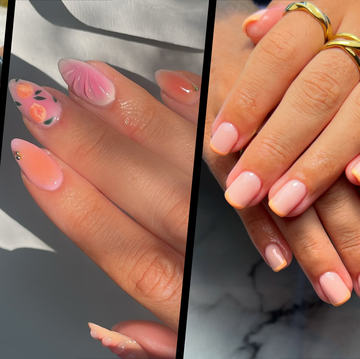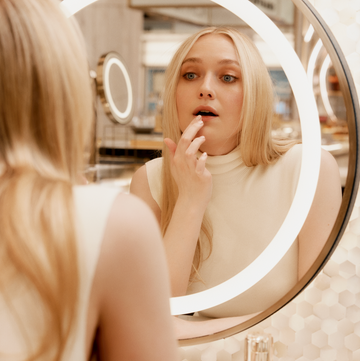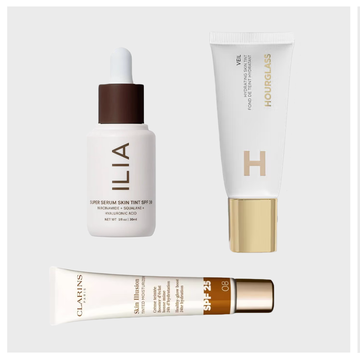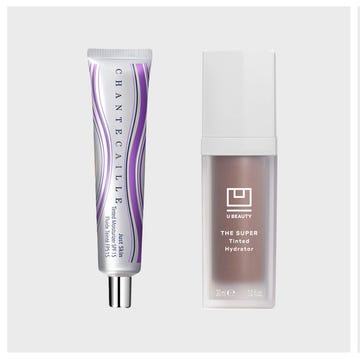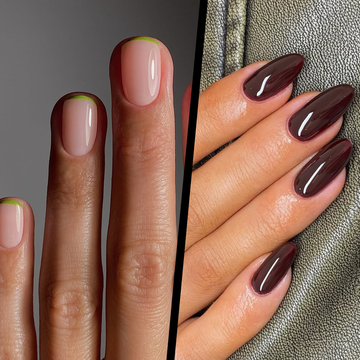The only thing that can dull the shine of a glossy manicure is knowing the damage that constant gel removal and reapplication might be doing to your nails. This is where BIAB, or Builder In A Bottle, comes in – an innovative leap in the mani-sphere that sits somewhere between offering the protection of acrylics and the flexibility of gel. And while BIAB has been around for almost a decade, it has gained most traction in the last year or so; the hashtag #biab currently amassing more than 480 million views on TikTok.
But what exactly is it? And why hasn't it completely replaced regular gel? Let us explain...
What are BIAB nails?
Builder In A Bottle was originally dreamed up (and trademarked) by The GelBottle Inc. in 2017. It is, essentially, an in-salon, soak-off, gel-based product that 'overlays' the natural nail with a tough coating, creating a protective shell that can last upwards of four weeks. "The BIAB system is formulated with ingredients that provide strength, flexibility, moisture regulation and durability to the nail," explains Giorgia Cappella, head of education at The GelBottle. The idea is that the BIAB overlay allows the natural nail to grow and strengthen underneath.
While the acronym BIAB is technically a trademark of The GelBottle, plenty of brands now have their own builders in bottles – often, for simplicity's sake, referred to as BIAB.
How is BIAB different to regular gel?
It's still a gel-based product, but BIAB is thicker than regular gel and, because of this, needs an expert hand to apply it. Its thickness (and associated curing time) is also the reason that when BIAB first came out, the colours were limited to neutrals. Now, though, there's an extended shade range, and you can also wear a layer of regular gel colour over the top of a BIAB base.
Another big difference, especially good to know if you're a fan of nude manis, is that BIAB won't 'lift' like some regular gel polishes do (always more visible with neutral shades). And while there are no particular downsides, BIAB costs more, takes longer, and can cause heat spikes in the nail during application (more below), which is why it hasn't completely eclipsed regular gel polish.
What are the advantages of BIAB's formula?
"BIAB is specifically designed to help us grow strong, natural nails," explains Cappella. In addition to the aforementioned protective shell that prevents chipping and breaking, "BIAB offers the nail significant structural support, making it an excellent choice for those with weak or brittle nails," she says. "The exceptional results of BIAB are largely thanks to its thicker consistency compared to regular gel polish. This allows for the creation of an 'apex'; a structural element where the product mimics the natural curve of the nail, and is thickest at the stress point. This stress point [where breakage and lift usually occur] becomes visible as a white band when gentle pressure is applied to the free edge of the nail. Creating a strong apex with BIAB is crucial for providing the necessary support that allows nails to grow longer without breakage," says Cappella.
Does BIAB actually improve nails?
It does in so much as it protects them from external factors that would otherwise damage, weaken and break them over time. But BIAB's ability to protect the nail relies on professional and careful removal when you want them off; careless removal will undo all the good work. "We stress that this is a professional product and should only be used by fully qualified and experienced techs to ensure it's used safely," says Cappella.
How is it applied?
The formula is, as we've mentioned, a thick, gel-base nail primer. It's applied and 'cured' under a UV/LED lamp much like regular gel. Nails are also prepped in the same way as they would be for a gel mani – filing, cuticle work, buffing – but the BIAB application takes a little longer (allow around an hour and a quarter for your appointment) as the technician has to carefully spread out the builder with a special brush once it's applied to the centre of the nail.
Is there a nail length that's too long for BIAB?
"BIAB is a great overlay product for most nail lengths," says Cappella, "but as the nail reaches 3-4mm at the free edge, we'd suggest switching over to a hard gel such as Gel Pot or Proform to provide extra strength and support."
How long does BIAB last?
Anywhere between 2-4 weeks depending on your lifestyle and how much wear and tear your hands see on a daily basis.
Should you get BIAB infills?
"We always recommend to complete at least 2-3 infills before every fresh set, unless a full removal is required," says Cappella. This would be decided when the technician checks the health of your natural nail at the beginning of your appointment. "During an infill, around 60% of the product will be removed, leaving a sheer layer over the natural nail, which helps maintain nail strength. It is, however, important to complete a full removal every 2-3 appointments to ensure nail health, perfect the structure and make sure the application remains effective," Cappella explains.
How is BIAB removed?
As BIAB is a soft gel product (unlike, say, acrylics), and assuming you have no nail art, it's filed and soaked off much like regular gel polish. Sometimes, if there is a build up of the BIAB overlay along with additional colour gel coats, your technician might choose an electric nail file (e file) over a manual one to remove the top layers of gel.
How much does BIAB cost?
At Townhouse, a BIAB overlay is costed as an add-on, and will add between £12 and £16 (depending on UK location) to the price of your manicure. Other salons will offer a builder option as a standalone treatment. At DryBy at Hershesons, for instance, BioSculpture offers a builder option within its BioSculpture Xtra Length Manicure, which costs £120 with an appointment lasting two hours.
Who can't use BIAB?
The original BIAB formula uses HEMA (hydroxyethyl methacrylate) as its curing agent, and this is what gives the manicure its longevity. If you have an allergy or sensitivity to HEMA, however, the The GelBottle's HEMA-free options really aren't far behind the original formula – you can get three weeks' wear out of them, and the shade range is almost identical.
"Also, clients with exceptionally oily nail beds may find that BIAB does not retain so well," adds Cappella. "They should potentially swapped it out for a hard gel system instead."
In any case, Cappella points out that "it's always important to complete a full consultation with your technician before proceeding to ensure you understand what is suitable."
What else to know about BIAB
Some people struggle with the heat spikes that can happen during the curing process (or polymerisation) of a BIAB mani. Because the product is thicker than regular gel, the UV/LED has to work harder to cure it, which is why the nails can feel like they're heating up. And the thinner your nails, the more you might feel it. If this is something you struggle with, Cappella suggests the following: "If you do feel a heat spike, the most important thing is to speak up and tell your nail technician. We are trained to recognise this and take steps to help. Most UV/LED lamps have a low heat setting, which slows down the curing process and minimises the reaction. Your tech might also be able to apply the product more thinly, or even choose and alternative."





